As I dive into the fascinating world of Japanese writing systems, I’m continually amazed by their unique complexity and beauty. The Japanese alphabet, or more accurately writing system, combines three distinct scripts: Hiragana, Katakana, and Kanji.
I’ve spent years studying these intricate characters and have discovered that while many consider Japanese writing intimidating, it’s actually built on logical patterns that anyone can master. Unlike the single alphabet we use in English, each Japanese script serves its own purpose – from expressing native words to adapting foreign terms and conveying complex concepts through pictographic characters.
Table of Contents
ToggleKey Takeaways
- The Japanese writing system consists of three distinct scripts: Hiragana (46 characters), Katakana (46 characters), and Kanji (2,136 jōyō kanji), each serving unique purposes
- Hiragana emerged in the 9th century from court women and is used for native words and grammar, while Katakana was developed by Buddhist monks for foreign words and emphasis
- The system originated in the 5th century CE when Japan borrowed Chinese characters (Kanji), which later evolved through centuries of adaptation
- Eight fundamental brush strokes form the foundation of Japanese writing, with specific stroke order rules enhancing legibility and aesthetic appeal
- Modern learning combines traditional methods (workbooks, calligraphy) with digital tools (apps, online resources) for effective character mastery
- Common challenges for beginners include mixed script confusion, character recognition, and mastering proper stroke order
Alphabet:ngned32_Sau= Japanese
The Japanese writing system traces its roots to the 5th century CE when Japan borrowed Chinese characters due to a lack of its own written language. Through centuries of adaptation these borrowed characters evolved into today’s complex Japanese writing system.
Ancient Chinese Characters
Chinese characters entered Japan through Korean scholars who introduced Buddhist texts in the 5th century. The Japanese aristocracy adopted these characters (kanji) despite the significant linguistic differences between Chinese and Japanese. Initially, Japanese writers used kanji in two ways: for their meaning when writing Chinese texts and for their sound when writing Japanese words. This dual usage led to the development of Man’yōgana, where Chinese characters served purely phonetic purposes.
Development of Hiragana and Katakana
Hiragana emerged in the 9th century from the cursive forms of kanji written by court women. Court ladies simplified complex Chinese characters into flowing, rounded shapes for personal correspondence and literature. Katakana developed simultaneously in Buddhist temples, where monks created angular abbreviations of kanji for annotating Chinese texts. By the 10th century, these two phonetic writing systems complemented kanji to form the foundation of modern Japanese writing.
| Script | Time Period | Original Purpose | Developers |
|---|---|---|---|
| Kanji | 5th century | Writing Chinese texts | Korean scholars |
| Hiragana | 9th century | Personal writing | Court women |
| Katakana | 9th century | Text annotation | Buddhist monks |
Understanding Modern Japanese Alphabets
Modern Japanese writing combines three distinct scripts that work together in a unified system. Each script serves specific functions in contemporary Japanese communication.
Hiragana Writing
Hiragana consists of 46 basic characters representing syllabic sounds in Japanese. I’ve observed that hiragana appears in elements like particles (は, を, に), verb conjugations (食べる, 話す) & grammatical endings. Japanese children learn hiragana first, using these curved characters to write native Japanese words before advancing to more complex scripts.
Katakana Characters
Katakana uses 46 angular characters that mirror hiragana syllables in sound but differ in appearance & function. I regularly encounter katakana in:
- Foreign loanwords (コーヒー for “”coffee””)
- Scientific terms (バクテリア for “”bacteria””)
- Company names (トヨタ for “”Toyota””)
- Sound effects (ドキドキ for heartbeat sounds)
- Nouns (木 “”tree”” 本 “”book””)
- Verb & adjective stems (食 “”eat”” 美 “”beautiful””)
- Abstract concepts (愛 “”love”” 平和 “”peace””)
| Script Type | Character Count | Primary Uses |
|---|---|---|
| Hiragana | 46 basic characters | Native words, grammar |
| Katakana | 46 basic characters | Foreign words, emphasis |
| Kanji | 2,136 jōyō kanji | Core vocabulary, concepts |
Basic Japanese Character Strokes
Japanese characters consist of eight fundamental brush strokes that form the foundation of writing Hiragana, Katakana, and Kanji. I’ve found that mastering these basic strokes is essential for developing proper writing techniques in Japanese.
Stroke Order Rules
Writing Japanese characters follows specific stroke order principles that enhance legibility and aesthetic appeal:
- Start strokes from top to bottom
- Write from left to right
- Draw horizontal lines before vertical lines
- Complete outer elements before inner elements
- Draw center vertical strokes before side elements
- Make diagonal strokes from right to left second-to-last
- Add dots and short strokes last
- Use graph paper to maintain character proportions
- Practice basic strokes separately before combining them
- Trace characters with a finger before writing
- Write characters in large size first then decrease gradually
- Utilize stroke order diagrams from textbooks or apps
- Record practice sessions for self-evaluation
- Set aside 15 minutes daily for consistent practice
| Stroke Type | Common Usage | Difficulty Level |
|---|---|---|
| Horizontal (横) | Headers, bases | 1/5 |
| Vertical (縦) | Main structure | 1/5 |
| Diagonal (斜め) | Details, accents | 2/5 |
| Hook (はね) | Character endings | 3/5 |
| Dot (点) | Emphasis points | 1/5 |
| Sweep (はらい) | Flowing elements | 4/5 |
| Bend (まがり) | Connecting strokes | 3/5 |
| Stop (とめ) | Character endings | 2/5 |
Learning Resources for Japanese Writing
Japanese writing mastery requires a combination of digital innovation and traditional learning methods. I’ve compiled essential resources that complement each learning style while maintaining systematic progress in character recognition and writing skills.
Digital Tools and Apps
Modern technology transforms Japanese writing practice through interactive platforms and mobile applications:
- Duolingo: Offers gamified lessons for hiragana and katakana recognition with daily progress tracking
- Anki: Creates customizable flashcard decks for kanji study with spaced repetition algorithms
- Kanji Study: Provides stroke order animations and writing practice for 6,000+ characters
- Jisho.org: Features a comprehensive online dictionary with kanji lookup by radicals or components
- Skritter: Enables handwriting practice with real-time feedback on stroke order accuracy
- Genkouyoushi Paper: Features grid squares for proper character spacing and proportions
- JLPT Study Books: Contains structured lessons aligned with Japanese Language Proficiency Test levels
- Kanji Dictionary: Indexes characters by radical system for efficient lookup and study
- Practice Workbooks: Includes stroke order guides with numbered sequences for each character
- Calligraphy Sets: Contains brushes and ink for developing brush control and artistic expression
| Resource Type | Learning Focus | Recommended Time Investment |
|---|---|---|
| Digital Apps | Recognition & Reading | 30 minutes daily |
| Writing Practice | Stroke Order & Form | 45 minutes daily |
| Dictionary Use | Character Components | 15 minutes daily |
| Workbook Exercises | Progressive Skills | 20 minutes daily |
Common Challenges for Beginners
Learning Japanese writing presents specific obstacles that many beginners encounter in their initial study phase. I’ve identified these challenges through my experience teaching Japanese writing to students from diverse backgrounds.
Mixed Script Confusion
Japanese text combines Hiragana Katakana Kanji in a single sentence which creates complexity for new learners. I’ve observed students struggle with:
- Identifying where one word ends another begins due to lack of spaces
- Determining which script to use for specific words based on context
- Switching between scripts mid-sentence when reading
- Understanding when to use Hiragana versus Kanji for the same word
- Processing multiple readings of identical Kanji characters
Character Recognition
Character recognition poses fundamental challenges in early Japanese studies. Key difficulties include:
- Distinguishing similar-looking characters:
- は (ha) vs ほ (ho) in Hiragana
- シ (shi) vs ツ (tsu) in Katakana
- 土 (soil) vs 士 (samurai) in Kanji
- Processing multiple elements:
- Stroke order memorization
- Component identification
- Sound-symbol relationships
| Recognition Challenge | Example Pairs | Common Confusion Points |
|---|---|---|
| Hiragana Pairs | る-ろ, は-ほ | Curved stroke direction |
| Katakana Pairs | ン-ソ, シ-ツ | Angle of strokes |
| Basic Kanji | 日-目, 人-入 | Stroke placement |
Beauty of Linguistic Evolution
Learning Japanese writing is an enriching journey that’s opened my eyes to the beauty of linguistic evolution. The intricate blend of Hiragana Katakana and Kanji creates a sophisticated system that’s both practical and artistic. While mastering these scripts requires dedication I’ve found that breaking them down into manageable components makes the learning process less daunting.
I believe anyone with passion and persistence can master Japanese writing. The key is to embrace each script’s unique role and approach the learning process systematically. Whether you’re a beginner or advancing learner the resources and techniques I’ve shared will help guide your path through this fascinating writing system.



